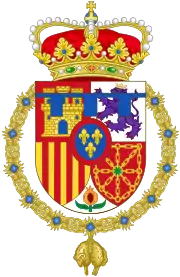Margaret of Austria, Duchess of Savoy
Archduchess Margaret of Austria (German: Margarete von Österreich; French: Marguerite d'Autriche; Dutch: Margaretha van Oostenrijk; Spanish: Margarita de Austria; 10 January 1480 – 1 December 1530), suo jure Countess of Artois, was Governor of the Habsburg Netherlands from 1507 to 1515 and again from 1519 to 1530. She was the first of many female regents in the Netherlands.
| Margaret of Austria | |
|---|---|
| Suo jure Countess of Artois Princess of Asturias Duchess of Savoy | |
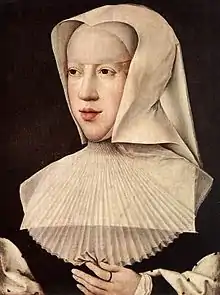 Portrait of Margaret as a widow painted by Bernard van Orley | |
| Governor of the Habsburg Netherlands | |
| Reign | 1507-1530 |
| Predecessor | William de Croÿ |
| Successor | Mary of Austria |
| Born | 10 January 1480 |
| Died | 1 December 1530 (aged 50) Mechelen, Duchy of Brabant |
| Spouse | |
| House | Habsburg |
| Father | Maximilian I, Holy Roman Emperor |
| Mother | Mary, Duchess of Burgundy |
| Religion | Roman Catholicism |
A central political figure of the early 16th century, Margaret was one of the greatest government administrators, political negotiators, and patrons of her time. She helped Emperor Charles V overcome his uncertain steps at the beginning of his reign and was an invaluable asset to his rule until her death.
Childhood and life in France
Margaret was born on 10 January 1480 and named after her stepgrandmother, Margaret of York. She was the second child and only daughter of Maximilian of Austria (future Holy Roman Emperor) and Mary of Burgundy, co-sovereigns of the Low Countries. In 1482, her mother died and her three-year-old brother Philip the Handsome succeeded her as sovereign of the Low Countries, with her father as his regent.
The same year her mother died, King Louis XI of France signed the Treaty of Arras, whereby her father promised to give her hand in marriage to Louis's son, Dauphin Charles. The engagement took place in 1483. With Franche-Comté and Artois as her dowry, Margaret was transferred to the guardianship of Louis XI, who died soon after. She was raised as a fille de France and prepared for her future role as Queen of France.

Under the supervision of her governess Madame de Segré, and Charles' sister, regent of France Anne de Beaujeu, Margaret received a fine education alongside several noble children, amongst whom was Louise of Savoy.[1]
Although their union was political, the young Margaret developed a genuine affection for Charles. However, he renounced the treaty in the autumn of 1491 and married her former stepmother Anne, Duchess of Brittany, for political reasons. The French court had ceased treating Margaret as their future queen but she could not return to her stepgrandmother's court until June 1493 after the Treaty of Senlis had been signed in May that year. She was hurt by Charles's actions and was left with a feeling of enduring resentment towards the House of Valois.
Marriages
Princess of Asturias
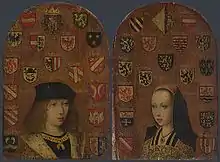
In order to achieve an alliance with Queen Isabella I of Castile and King Ferdinand II of Aragon, Maximilian started negotiating the marriage of their only son and heir, John, Prince of Asturias, to Margaret, as well as the marriage of their daughter Juana to Philip. Margaret left the Netherlands for Spain late in 1496. Her engagement to the Prince of Asturias seemed doomed when the ship carrying her to Spain hit a storm in the Bay of Biscay. In haste, she wrote her own epitaph should she not reach Spain:
"Here lies Margaret, the willing bride,
Twice married - but a virgin when she died."
However, Margaret actually married Prince John on 3 April 1497 in Burgos Cathedral. Although it was a political alliance, it was a good marriage and John was devoted to the Princess, who was fun-loving and had a sharp sense of humor. Tragically, John died of a fever after only six months, on 4 October. Margaret was left pregnant, but she gave birth to a premature stillborn daughter on 2 April 1498.[2]
With neither husband nor heir, Margaret served no great geo-political purpose in Spain. Her parents-in-law treated her kindly and reluctantly bid her farewell when she departed for the Low Countries in September 1499 at Maximilian's insistence. Back in Flanders, the Dowager Princess of Asturias attended the baptism of her nephew, the future Charles V, on 7 March 1500. Her brother and sister-in-law invited her to be godmother to their newborn son.
Duchess of Savoy
In 1501, Margaret married Philibert II, Duke of Savoy (1480–1504), whose realm played a decisive role in the rivalry between France and the Habsburgs in Italy on account of its strategic position in the Western Alps. Devoted to the hunt and his wife, Philibert showed little interest in governing his domains. Margaret willingly managed his affairs from their residence in the castle of Pont d'Ain at Bourg. Of those years in Italy, Ghislaine de Boom wrote: "For the first time, Margaret was revealed as an able and energetic woman, even imperious." The union was extremely happy, but childless and brief.
By 1504, Philibert died of pleurisy. Grief-stricken, Margaret threw herself out of a window, but was saved. After being persuaded to bury her husband, she had his heart embalmed so she could keep it with her forever.[3] The Dowager Duchess cut off her long blonde hair and donned widow's clothing. She considered taking religious vows for a while, but instead endowed the construction of a monastery at Brou with an elaborate tomb for Philibert and herself with the words "FORTUNE. INFORTUNE. FORT. UNE" ("Fortune strongly persecutes a woman").
Margaret remained in Savoy for two years following her husband's death. Without her consent, Philip and Maximilian negotiated her marriage to King Henry VII of England. She refused to cooperate, determined to avoid further marital sorrow. Her court historian and poet Jean Lemaire de Belges gave her the title "Dame de deuil" (Lady of Mourning).[4]
Governor of the Habsburg Netherlands
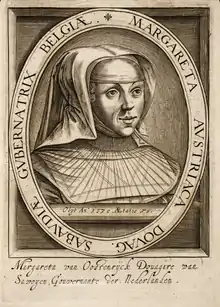
Queen Isabella died in late 1504, and Philip and Juana went to Castile to claim the crown. Their eldest son stayed behind, for the Burgundians refused to accept him as their ruler unless he was brought up in the Low Countries. After Philip's death, the House of Habsburg entered a new crisis: Charles was the new sovereign of the Low Countries, but he was young and alone. Juana could not return to act as regent because her unstable mental state and her Castilian subjects would not allow their ruler to abandon the kingdom. With Charles too young to govern, the provinces of the Low Countries voted to make Maximilian their regent. Preoccupied with his affairs in Germany, the now Emperor named Margaret governor of the Low Countries and guardian of Charles in 1507, along with her nieces Eleanor, Isabella and Mary. She became the only woman elected as its ruler by the representative assembly of Franche-Comté, with her title confirmed in 1509.
Although her mother was a previous sovereign of the Netherlands, Margaret was always considered a foreigner because of her childhood at the French court. She knew neither Dutch nor German, and her principal advisers, such as Mercurino di Gattinara, were Italians who had followed her north. In any case, the Governess acted as intermediary between her father and her nephew's subjects in the Netherlands from her newly built palace at Mechelen. During a remarkably successful career, she broke new ground for women rulers.[5]
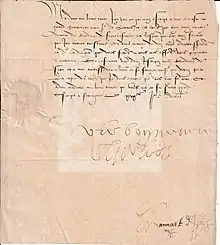
While she lavished great care on her young nephew's education, Margaret immediately confronted his tutor William de Croy, lord of Chièvres and a dominant political figure at court. He retained the boy's trust, but his pro-French leanings brought him into conflict with her support for the Emperor. Jealous of her power, Croy and some nobles secretly pressed Emperor Maximilian to declare Charles of age to rule. The Estates paid Maximilian to resign as regent and installed Charles, who was not yet 15 years old, on 1515. Margaret's dethronement was a public humiliation. In his aunt's place, Charles established a council of regency, of which she was part but had no vote in its deliberations. Her ministers found themselves thrust aside and even persecuted. Maximilian shortly saw his mistake towards his intelligent, angry daughter, but Croy completely dominated Charles and urged upon him policies that not only conflicted with Habsburg interests, but gave little in return. King Ferdinand's death opened the way to her nephew's Spanish inheritance, but he had to go to Spain to claim it. After participating in councils with Croy and his ministers for a while, Charles soon recognized his need for Margaret and her ministers. In June 1518, he appointed Gattinara chancellor and helped arrange Margaret's return as regent of the Low Countries.
On a subsequent visit to the Low Countries in mid-1520, Charles made Margaret his governor-general "in consideration of the great, inestimable and praiseworthy services that our said lady and aunt has done us." He recognized his aunt as one of his wisest advisers and the only regent he ever re-appointed indefinitely from 1519 until her death in on 1 December 1530.[6]
Economy
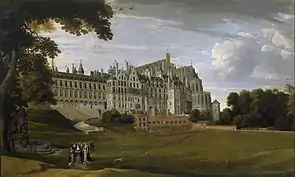
Margaret had an aptitude for business, and maintained the prosperity of the Netherlands. She negotiated the restoration of Intercursus Magnus with England, which was favorable to the Flemish textile interests and brought huge profits.[7][8] Because of the trade, industry and wealth of the regions and cities she oversaw, the Low Countries was an important source of income for the Imperial treasury.
Margaret provided funds and war supplies for her nephew's troops, especially against King Francis I of France and the German Protestants. In following years, Habsburg forces consolidated their hold over Tournai, Friesland, Utrecht, and Overijssel, which became part of the Netherlands.
Internal conflict
Although the Low Countries initially lacked any centralized political institutions, Margaret's reign was a period of relative peace for the Netherlands. The exception was the beginning of the Protestant Reformation, especially in the north. The first martyrs were burnt at the stake in 1523.
More moderate than her nephew, the Governess feared that intense persecution of Protestants would only strengthen them. She had some difficulty in keeping Duke Charles of Guelders under control, but made him sign the Treaty of Gorinchem in 1528. Despite her efforts, the problem was not conclusively dealt with during her reign.
Foreign policy
_22x17_Inv.1013.jpg.webp)
Margaret soon found herself at war with France over the question of Charles's requirement to pay homage to the French king for Flanders as Duke of Burgundy. To preserve the Low Countries for her nephew, she persuaded Emperor Maximilian to make peace with King Louis XII. She journeyed to Cambrai in November 1508 to form the League of Cambrai, which largely removed the French threat to the Low Countries.[7][8]
To curb Croy's pro-French influence over Charles, Margaret persuaded her father to join a papal alliance with Spain and England against France in 1513, although she maintained the Low Countries in neutrality. They created a council containing representatives of Emperor Maximilian, King Ferdinand, and King Henry VIII.
Given her father's poor health, Margaret and Charles began to negotiate the latter's election as Holy Roman Emperor despite the papacy and French being strongly opposed to this. Thinking first of the dynasty, the Governess suggested supporting instead her younger nephew Ferdinand, but Charles refused to withdraw. Using a combination of diplomacy and bribery, she played a crucial role in the election of Charles as Holy Roman Emperor in 1519.[7][8]
Journeying to Cambrai again in 1529, Margaret reunited with Louise of Savoy, his sister-in-law and mother of Francis I. They negotiated the end to a war that France could no longer sustain. The Treaty of Cambrai, the so-called Ladies' Peace, favored the dynastic interests of Charles: besides withdrawing French forces from Italy, Francis renounced his claims to Flanders, Artois and Tournai.
Patronage of the arts

Once she was declared Governor of the Netherlands, Margaret purchased the palace of Jean Laurin, Lord of Watervliet, located in the Korte Maagdenstraat (Virgins Short Street). She found the residence too small and started an ambitious expansion campaign in 1507. From 1517 to 1530, the architect Rombout II Keldermans furthered the project along the Keizerstraat (Emperor Street) and modified what became the rear wing, which faces the Palace of Margaret of York. The Governess kept several painters at her court, including the Master of the Legend of the Magdalen and Pieter van Coninxloo.
Margaret possessed a rich library, consisting mostly of missals, poetry, historical and ethical treatises, which included the works of Christine de Pizan and the famous illuminated Très Riches Heures du duc de Berry.[9] She possessed several Chansonniers[10] which contained works by Josquin des Prez, Johannes Ockeghem, Jacob Obrecht and Pierre de la Rue, who was her favourite composer. The Governess patronized writers and artists. Visiting her palace in 1521, Albrecht Dürer wondered at her many "precious things and precious library."
Margaret ended up raising her nephew and nieces in her palace. Her court was visited by the great humanists of her time, including Erasmus, Adrian of Utrecht (later Pope Adrian VI), and Heinrich Cornelius Agrippa.[11][12] Agrippa dedicated his arguably feminist work "Declamation on the Nobility and Preeminence of the Female Sex" to her.[13] The Governor was so impressed with diplomat Thomas Boleyn's charm that she offered his daughter Anne Boleyn (future Queen consort of England) a temporary place in her household. She reported to the English nobleman that the little girl was "so presentable and so pleasant, considering her youthful age, that I am more beholden to you for sending her to me, than you to me."
Margaret ordered several splendid music manuscripts from Pierre Alamire to send them as gifts to her relatives and political relations.[14] She had one of the earliest collections of objects from the New World. Hernán Cortés had presented Charles V with treasures received from the Aztec King Moctezuma in 1519. Several of these treasures were sent to Mechelen as a gift from her nephew in 1523.[15]
Portraits
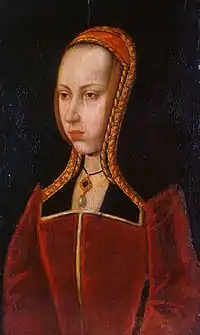 Margaret of Austria c. 1500. Attributed to Pieter van Coninxloo.
Margaret of Austria c. 1500. Attributed to Pieter van Coninxloo.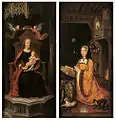 Margaret of Austria Worshipping by Anonymous (Southern Netherlands) between 1500 and 1510; Museum of Fine Arts, Ghent.
Margaret of Austria Worshipping by Anonymous (Southern Netherlands) between 1500 and 1510; Museum of Fine Arts, Ghent.
Death and Burial
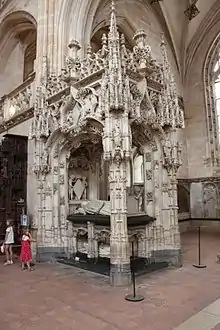
According to a legend about Margaret's death, one of her maids broke a glass goblet, a splinter of glass went into her foot, and the resulting wound became gangrenous. Her doctors strongly recommended that she agree to having her foot amputated. She gave her consent for the operation and received the sacrament, but she died before the operation from an overdose of opium given to her for the treatment.[16] In reality, however, Margaret's health had declined since 1527 and an abscessed leg had tormented her during the negotiations in Cambrai. On 20 November 1530, a high fever caused by her infected leg forced her to bed and neither piety nor medicine made any headway against the spreading gangrene. She died shortly after midnight on December 1.
The Emperor bemoaned "the loss that we have made and principally I who held her as a mother and for the lack she does me in the government of the countries where she was in charge." Margaret's will appointed Charles as her sole heir and urged her nephew to protect the sovereignty of the Low Countries against the centralizing tendency of his imperial administrators. She was buried alongside her second husband at Bourg-en-Bresse, in the mausoleum of the Royal Monastery of Brou that she previously commissioned.[17] There is a statue of the Governess next to the Cathedral of Mechelen.
Heraldry
.svg.png.webp) Arms as a single lady (before 1496)
Arms as a single lady (before 1496).svg.png.webp) Arms as princess of Spain (1496-1501)
Arms as princess of Spain (1496-1501).svg.png.webp) Arms as duchess of Savoy (after 1501)
Arms as duchess of Savoy (after 1501).svg.png.webp) Arms as countess of Burgundy and Artois (after 1509)
Arms as countess of Burgundy and Artois (after 1509)
Depiction in media
Margaret of Austria is portrayed by Spanish actress Úrsula Corberó in the TV show Isabel.[18]
Ancestry
References
- Diana Maury Robin, Anne R. Larsen and Carole Levin (2007). Encyclopedia of women in the Renaissance: Italy, France, and England. ABC-CLIO, Inc. p. 43.CS1 maint: uses authors parameter (link)
- N. de Aragón in: geneall.net [retrieved 7 October 2015].
- Jansen, Sharon L. (2002). The Monstrous Regiment of Women: Female Rulers in Early Modern Europe. p. 88.
- Gonkdo, Michal (2006). Dame de Deuil. Musical Offerings for Marguerite of Austria (1480-1530), 3. CD Booklet KTC 4011
- Enno van Gelder, H.A. en Van Houtte, J.A. (1971). Margaretha van Oostenrijk, in: Grote Winkler Prins, vol. 12, p. 610-611. Amsterdam, Elsevier.
- Enno van Gelder, H.A. en Van Houtte, J.A. (1971). Margaretha van Oostenrijk, in: Grote Winkler Prins, vol. 12, p. 610-611. Amsterdam, Elsevier.
- Jansen 2002, p. 94.
- Tremayne 1918, p. 240.
- Schreurs, Eugeen; Vendrix; Philippe (2005). The sweet melancholy of Margaret, translated by Celia Skrine, 11. CD Booklet MEW 0525.
- Schreurs, Eugeen (1998). Margarete – Maximilian I, translated by Stratton Bull, 14. CD Booklet ORF CD 265.
- Tremayne, Eleanor E. (1918). The First Governess of the Netherlands, Margaret of Austria. Library of Alexandria. p. 379. ISBN 9781465517579.
- Triest, Monica (2000). Macht, vrouwen en politiek 1477-1558. Maria van Bourgondië, Margaretha van Oostenrijk, Maria van Hongarije. Leuven, Van Halewijck.
- LeGates, Marlene (2012). In Their Time: A History of Feminism in Western Society. Routledge. p. 111. ISBN 9781136779039.
- Kellman, Herbert (ed.) (1999). The Treasury of Petrus Alamire. Music and Art in Flemish Court Manustricpts 1500-1535. Leuven, Die Keure.
- MacDonald, Deanna (2002). "Collecting a New World: The Ethnographic Collections of Margaret of Austria". The Sixteenth Century Journal. 33 (3): 649–663. doi:10.2307/4144018. JSTOR 4144018.
- Gristwood, Sarah (2016). Game of Queens. New York: Basic Books. p. 149.
- "Brou". Centre des monuments nationaux. Retrieved 2018-03-04.
- "Personaje Margarita de Austria". RTVE. Retrieved 2 March 2016.
- Wurzbach, Constantin, von, ed. (1860). . Biographisches Lexikon des Kaiserthums Oesterreich [Biographical Encyclopedia of the Austrian Empire] (in German). 6 – via Wikisource.
- Chisholm, Hugh, ed. (1911). . Encyclopædia Britannica. 11 (11th ed.). Cambridge University Press.
- Holland, Arthur William (1911). . In Chisholm, Hugh (ed.). Encyclopædia Britannica. 17 (11th ed.). Cambridge University Press.
- Wurzbach, Constantin, von, ed. (1860). . Biographisches Lexikon des Kaiserthums Oesterreich [Biographical Encyclopedia of the Austrian Empire] (in German). 6. p. 158 – via Wikisource.
- Urban, William (2003). Tannenberg and After. Chicago: Lithuanian Research and Studies Center. p. 191. ISBN 0-929700-25-2.
- Stephens, Henry Morse (1903). The story of Portugal. G.P. Putnam's Sons. p. 139. Retrieved 11 July 2018.
- "Leonora of Aragon (1405–1445)". Women in World History: A Biographical Encyclopedia. Gale Research. Retrieved 11 July 2018.
- Chisholm, Hugh, ed. (1911). . Encyclopædia Britannica. 21 (11th ed.). Cambridge University Press.
- Poupardin, René (1911). . In Chisholm, Hugh (ed.). Encyclopædia Britannica. 5 (11th ed.). Cambridge University Press.
- Anselme de Sainte-Marie, Père (1726). Histoire généalogique et chronologique de la maison royale de France [Genealogical and chronological history of the royal house of France] (in French). 3 (3rd ed.). Paris: La compagnie des libraires. p. 137.
- Kiening, Christian (1994). "Rhétorique de la perte. L'exemple de la mort d'Isabelle de Bourbon (1465)". Médiévales (in French). 13 (27): 15–24. doi:10.3406/medi.1994.1307.
- O'Reilly, Elizabeth Boyle (1921). How France Built Her Cathedrals. London: Harper Brothers Publishers. p. 265.
The present choir of Moulins Cathedral, originally the chapel of their palace, was built by Agnes of Burgundy, daughter of Jean sans Peur [John the Fearless]
Bibliography
| Wikimedia Commons has media related to Margaret of Austria. |
- Margarete - Maximilian I. Musik um 1500, Capilla Flamenca with La Caccia, Schola Cantorum Cantate Domino Aalst, Schola Gregoriana Lovaniensis, 1998, ORF Shop CD 265 (2 CDs).
- Dulcis Melancholia, Biographie musicale de Marguerite d'Autriche, Capilla Flamenca, 2005 (MEW 0525).
- Dame de Deuil. Musical Offerings for Marguerite of Austria, La Morra, 2005 (KTC 4011).
- Diana Maury Robin, Anne R. Larsen and Carole Levin (2007). Encyclopedia of women in the Renaissance: Italy, France, and England. ABC-CLIO, Inc.CS1 maint: uses authors parameter (link)
- . Encyclopædia Britannica. 17 (11th ed.). 1911. p. 703.
- Jansen, Sharon L. (2002). The monstrous regiment of women: female rulers in early modern Europe. Palgrave Macmillan. ISBN 0-312-21341-7.
- Margaret of Austria (1480–1530) Encyclopedia
Margaret of Austria, Duchess of Savoy Born: 10 January 1480 Died: 1 December 1530 | ||
| Political offices | ||
|---|---|---|
| Preceded by William de Croÿ |
Governor of the Habsburg Netherlands 1507–1530 |
Succeeded by Mary of Hungary |
| Italian nobility | ||
| Preceded by Yolande Louise of Savoy |
Duchess consort of Savoy 1501–1504 |
Vacant Title next held by Beatrice of Portugal |
